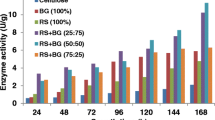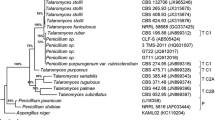Abstract
When grown on a purified cellulose such as CF11 cellulose,Aspergillus fumigatus produces mainly exoglucanase (Avicelase) and endoglucanase (CMCase) with small amounts of Β-glucosidase and xylanase. In such cultures, the pH drops to 3–3.5 after 2 d incubation, which may account for the low levels of Β-glucosidase.
The amounts of extracellular enzymes produced are larger when the organism is grown on hay or straw than when grown on CF11 cellulose. In particular, CMCase levels increase approximately seven times and xylanase levels increase 40–50 times. In such cultures the pH remains fairly constant at 6–7 over the 10-d incubation period used and so Β-glucosidase levels are also increased.
Extraction of the hay or straw substrate with ethanol had little effect on enzyme production and so there appears to be no soluble material present that influences enzyme production.
The organism produced elevated levels of CMCase and xylanase on barley straw, oat straw, and wheat straw, there being little difference between the varieties of each tested. However, grasses dried at elevated temperatures (260–500‡C) gave enzyme levels similar to CF11 cellulose. Similarly, chemical delignification of hay or straw gave enzyme levels similar to CF11 cellulose. Thus, both these treatments must lead to degradation of the hemicellulose present in the substrate.
A. fumigatus was able to grow on a number of laboratory prepared and commercially available xylans (hay, barley straw, oat straw, and larch) as a pelletted mycelium. In all cases xylanase levels were increased 10–30 times over CF11 cellulose as substrate, but CMCase levels were similar to those with CF11 cellulose as substrate. Β-Glucosidase in most cases was not detectable, probably because the pH fell to 3–3.5 during incubation. Thus it appears that cellulase and xylanase can be independently induced in this organism.
The optimum incubation time at 37‡C for xylanase production was 4–7 d and the optimum concentration of hay as substrate was 4–5%, even though this produces a very thick slurry that does not shake well.
Similar content being viewed by others
Author information
Authors and Affiliations
Rights and permissions
About this article
Cite this article
Stewart, J.C., Lester, A. & Milburn, B. Xylanase and cellulase production byAspergillus fumigatus . Appl Biochem Biotechnol 9, 417–418 (1984). https://doi.org/10.1007/BF02799004
Issue Date:
DOI: https://doi.org/10.1007/BF02799004




